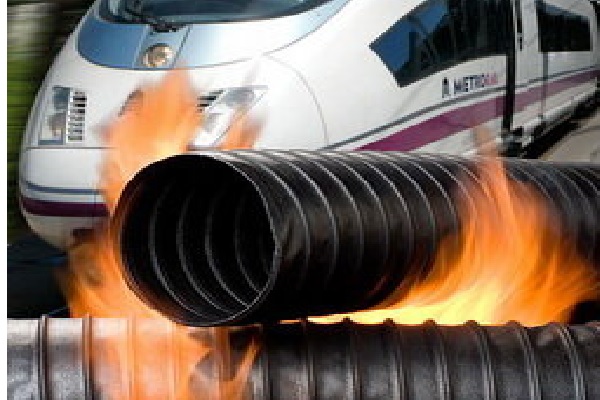
EN 45545-2_R22 European standard
EN 45545 is a European standard that specifies the “fire performance requirements for materials and product used on railway vehicles”[1] in order to protect passenger and staff in railway vehicles in the event of a developing fire on board[2]. The part of the standard that applies to Jehbco products is R22 which has a section about the requirements for interior seals[3]. This standard section is now used in replacement of BS 6853 which was a smoke safety standard for the rail industry[4].
The methods to perform testing are detailed in the standard. It consists of 3 tests that are used to establish product performance versus these product requirements:
- Oxygen index (EN ISO 4589-2): this test determines the burning behaviour at ambient temperature[5]. It is defining the minimum concentration of oxygen in a mixture of oxygen/nitrogen that will support flaming combustion.
- Smoke density (ISO 5659-2): this test measures the smoke production from the exposed surface of materials or composites[6].
- Smoke toxicity (NF X70-100): this test quantitively determines the thermal decomposition and combustion of materials decisive for the toxicity of the fire environment[7].
The standard defines three hazard levels: HL 1, HL 2 and HL 3; HL1 being the lowest requirement and HL 3 the highest. The performance requirements on EN 45545-2 for each of these tests is summarized below:
Table 1: Summary of test methods
| Test Method | Parameter Unit | Maximum or minimum | HL 1 | HL 2 | HL 3 |
|
Oxygen Index (EN ISO 4589-2: OI) |
Oxygen content % | Minimum | 28 | 28 | 32 |
|
Smoke Density (EN ISO 5659-2: 25 kWm-2) |
Ds max dimensionless |
Maximum | 600 | 300 | 150 |
| Smoke Toxicity
(NF X 70-100-1 & -2 600°C) |
CITNLP dimensionless | Maximum | 1.2 | 0.9 | 0.75 |
Ds max is the maximum optical density in the test chamber
CITNLP is the conventional index of toxicity for non- listed product
Jehbco is proud to inform that their Jehbsil black flame retardant products with hardnessess going from 30 to 90 Sh A have successfully met the requirements of the PN EN45545 2 + A1:2015 standard for R22 and R23 at the HL 1, HL 2 and HL 3 hazard levels in November 2020.
References
- European Committee for standardization. EN 45545-2:2020 standard. “Railway applications – Fire protection on railway vehicles – Part 2: Requirements for fire behavior of materials and components”, August 2020
- European Standard. “Set DIN 45545-1-7- Fire protection on railway vehicles”. Viewed on 31st March 2021https://www.en-standard.eu/set-din-en-45545-1-7-fire-protection-on-railway-vehicles/
- DGE smart speciality chemicals, “EN 45545-2 European railway standard for fire safety”, viewed on 31st March 2021. https://dge-europe.com/en-45545-european-railway-standard-fire-safety/
- Nathan White, CSIRO , “Fire Performance of Passenger Trains”, FPA Australia, viewed on 31st March 2021. fpaa.com.au/media/229521/d1-fse-p5-white.ppt.pdf
- International Standard Organisation, “ISO 4589-2:2017(en). Plastics — Determination of burning behaviour by oxygen index — Part 2: Ambient-temperature test”. Viewed on 31st March 2021.https://www.iso.org/obp/ui/#iso:std:iso:4589:-2:ed-2:v1:en
- International Standard Organisation, “ISO 5659-2:2017 Plastics — Smoke generation — Part 2: Determination of optical density by a single-chamber test”, viewed on 31st March 2021. https://www.iso.org/standard/65243.html
- Sychta laboratorium, “the toxicity test for thermal decomposition and combustion products of materials with methods according to NF X70-100-1, NF X70-100-2 and PN-EN 45545-2”. viewed on 31st March 2021. http://www.sychta.eu/en/nf-x70-100-1.html


